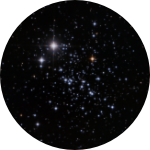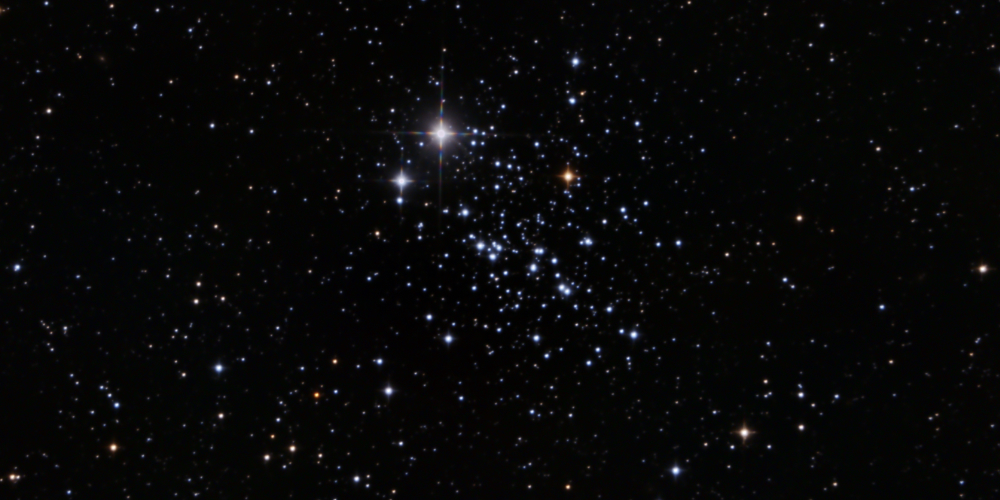 Owl Cluster/NGC 457 - a whimsical star cluster resembling an alien owl Owl Cluster/NGC 457 - a whimsical star cluster resembling an alien owl |  | NGC 457 is a delightful and distinctive open cluster located in the constellation Cassiopeia, and it’s a must-see for any stargazer with a small telescope. Also affectionately known as the “Owl Cluster” or the “E.T. Cluster”, this collection of stars really does resemble a tiny figure with outstretched arms and glowing eyes, especially at low to moderate magnification.
The two bright stars that form the “eyes” — Phi Cassiopeiae and HD 7902 — immediately draw your attention. From there, the fainter stars seem to stretch outward, creating the appearance of wings or arms, giving the cluster its owl- or alien-like shape. Once you see the figure, it’s hard to unsee it — and that makes NGC 457 especially fun for star parties, outreach events, and casual viewing.
NGC 457 is located just south of the “W” shape of Cassiopeia, and is easy to find with a small telescope or binoculars. It shines at around magnitude 6.4, making it visible under suburban skies. Even a 4” scope will reveal the full figure, while larger scopes bring out additional background stars and structure.
It’s one of those clusters that combines a striking visual pattern, a great nickname, and solid brightness, making it a favorite of amateur astronomers everywhere. If you haven’t yet met the Owl or E.T. in the sky, it’s time to say hello!
| | | Owl Cluster/NGC 457 | Target
Rating | 🔵 Stagazer Favorite | Star-Hop
Level | 🟢 Moderate | Best
Viewing | September through February | NGC 457, also known as the Owl Cluster or E.T. Cluster, is one of those rare deep-sky objects that’s not only visually distinctive, but also easy to find, fun to observe, and great for stargazers of all levels. Here are some of the best reasons to add NGC 457 to your observing list:
⭐️ It has a unique and recognizable shape
● Once you see the “owl” figure — with two bright “eyes” and outstretched “wings” — you’ll never forget it.
● It’s one of the few clusters that truly resembles something, which makes it great for outreach, kids, and casual viewing.
● The pattern is especially striking at low to medium power (50x–100x).
⭐️ It’s bright and easy to find
● At magnitude 6.4, NGC 457 is visible in binoculars and small scopes, even from suburban skies.
● Located just below the W-shaped asterism of Cassiopeia, it’s a quick and rewarding star-hop away.
● You can even see it as a faint fuzzy patch in a finder scope or with averted vision through binoculars.
⭐️ It looks great in all types of telescopes
● In small telescopes (3”–4”), you’ll clearly see the bright “eyes” and the overall form.
● In medium and large scopes, the field fills with additional fainter stars, giving depth and structure to the cluster.
● It holds up well under different sky conditions — even Bortle 5 skies still show the figure nicely.
⭐️ It’s educational and memorable
● NGC 457 is an ideal object to introduce concepts like open clusters, stellar brightness, and asterisms.
● It’s a perfect “first deep-sky object” for beginners and younger observers.
⭐️ It adds fun and personality to your session
● Nicknamed clusters are always crowd-pleasers, and this one sparks imagination and conversation.
● Whether you’re doing solo stargazing or leading a group, it’s a whimsical, rewarding object that adds flavor to an observing night.
|
| Finding: Owl Cluster/NGC 457 |  Find the constellation Cassiopeia and the two end stars Segin (+3.34) and Ruchbah (+2.68).
Find the constellation Cassiopeia and the two end stars Segin (+3.34) and Ruchbah (+2.68).
 Hop two times, first from the Segin to Ruchbah, and then to the Owl Cluster which may appear starlike in dark skies. If you can't see it, simply estimate its position.
Hop two times, first from the Segin to Ruchbah, and then to the Owl Cluster which may appear starlike in dark skies. If you can't see it, simply estimate its position.
 Using a binocular, telescope finder, low-powered telescope eyepiece, find the Owl Cluster. Increase power to confirm and explore.
Using a binocular, telescope finder, low-powered telescope eyepiece, find the Owl Cluster. Increase power to confirm and explore.
|
| Viewing: Owl Cluster/NGC 457 |  | Viewing Tips
NGC 457 is a fun, bright, and character-filled open cluster — and it looks fantastic through a wide range of equipment. Here are some top tips to help you get the best view of this charming celestial figure:
⭐️ Use low to medium magnification
● Start with low power (30x–50x) to frame the whole cluster.
● Increase to moderate power (75x–100x) to bring out the details of the fainter stars.
⭐️ Use a reflector
● For most observers, the 'owl' is upside-down in the sky. A reflector will turn it right-side up.
⭐️ Easy to find in Cassiopeia
● NGC 457 lies just below the “W” shape of Cassiopeia, making it a quick and easy star-hop.
● Look about 2° southeast of Ruchbah (Delta Cassiopeiae).
● It’s bright enough to be seen in binoculars or even a finder scope as a fuzzy patch.
⭐️ Works well even in light-polluted skies
● Unlike faint nebulae or galaxies, NGC 457 isn’t washed out easily by skyglow.
● It holds up well under Bortle 4–5 suburban skies, though darker skies will bring out fainter stars.
● No filters are needed — just clean optics and dark adaptation.
⭐️ Best viewed from late summer through winter
● NGC 457 is well placed in the evening sky from September through February.
● In mid to late fall, it’s nearly overhead in the Northern Hemisphere during prime observing hours.
|  | ❌ Naked Eye
● Visibility: Not visible under most sky conditions.
● At magnitude ~6.4, the cluster is too faint to resolve with the naked eye.
● Under very dark skies (Bortle 1–2), you might perceive a slight fuzzy patch if you know exactly where to look.
|  | ⚠️ Binoculars (7x50, 10x50, 15x70)
● Visibility: Faint but detectable as a fuzzy patch.
● Appears as a soft, hazy glow, perhaps with the two bright “eye” stars standing out.
● The shape isn’t clear yet, but it’s enough to locate and center the cluster for closer inspection with a telescope.
|  | ✅ Small Telescope (<4")
● Visibility: Distinct and charming view.
● At low to medium magnification (40x–80x), you’ll clearly see:
● The two bright stars (the “eyes”).
● A loose scatter of fainter stars forming the “arms” or “wings.”
|  | ✅ Medium Telescope (4-8")
● Visibility: Best balance of structure and context.
● The figure becomes much more defined, with dozens of fainter stars surrounding the core.
● The “arms” extend outward clearly, and the overall shape is more symmetrical and expressive.
● A wide-field eyepiece (60x–100x) frames the entire cluster perfectly, adding depth to the field.
|  | ✅ Large Telescope (10"+)
● Visibility: Bright and detailed — but more stars can crowd the figure.
● The “eyes” are brilliant, and the full form is still recognizable.
● The field becomes rich with additional fainter stars, giving a deep 3D look — though for some, the “figure” gets a little lost in the density.
● Excellent for detailed study or sketching, but be sure to use lower power (50x–100x) to keep the full shape in view.
|
| Sky Darkness Level | Viewing Quality |
| NGC 457 holds up surprisingly well even in moderate light pollution. However, your view of it will still vary based on the Bortle class.
|
| Bortle 1 (Pristine Dark Sky) |
✅ Stunning view. The cluster is easy to locate, even in a finderscope or binoculars. Dozens of stars are visible, including the two bright “eye” stars and the delicate arcs of fainter stars forming the arms/wings. The figure of the Owl or E.T. is immediately recognizable, almost like a tiny constellation.
|
| Bortle 2 (Very Dark Sky) |
✅ Excellent visibility. The overall figure remains sharp and clean, and faint stars in the background enhance depth. The bright “eyes” are very prominent, and the star pattern stands out well from the dark sky. A wide-field eyepiece gives a postcard-worthy view of the cluster.
|
| Bortle 3 (Rural) |
✅ Very good view. Most of the figure is still easily visible; about 30–40 stars show up in a medium telescope. The “arms” are slightly less delicate, but the shape is still clearly identifiable. Good sky contrast keeps the “face” sharp and clean.
|
| Bortle 4 (Rural/Suburban Edge) |
✅ Still solid, especially in a small or medium telescope. The bright stars forming the eyes and shoulders are clearly visible. Fainter stars begin to blend into the background, and the “arms” lose some definition. The E.T./Owl shape is still recognizable, especially with low to medium magnification (50x–80x).
|
| Bortle 5 (Suburban) |
✅ Slightly washed out, but still enjoyable. The “eye” stars remain visible and dominate the view. You may only see the brightest 10–15 stars, depending on aperture. The overall “figure” becomes harder to make out, but the core stars still sparkle nicely.
|
| Bortle 6-7 (Bright Suburbs to City Edge) |
⚠️ Challenging but possible. The two brightest stars are still visible and look like a bright double or pair. The rest of the cluster appears faint or diffuse, and you’ll need a moderate telescope (6”+) to resolve structure. The “Owl” may look fragmented or incomplete.
|
| Bortle 8-9 (Urban/Inner city) |
❗ Minimal visibility. Only the two brightest “eye” stars are visible, maybe a couple of surrounding stars. The cluster loses its form completely and may resemble just a small asterism. Best viewed with a larger telescope (8”+) at low power.
|
| | ▶︎ Constellations of Fall
▶︎ Cassiopeia
▶︎ Owl Cluster |
|
|



